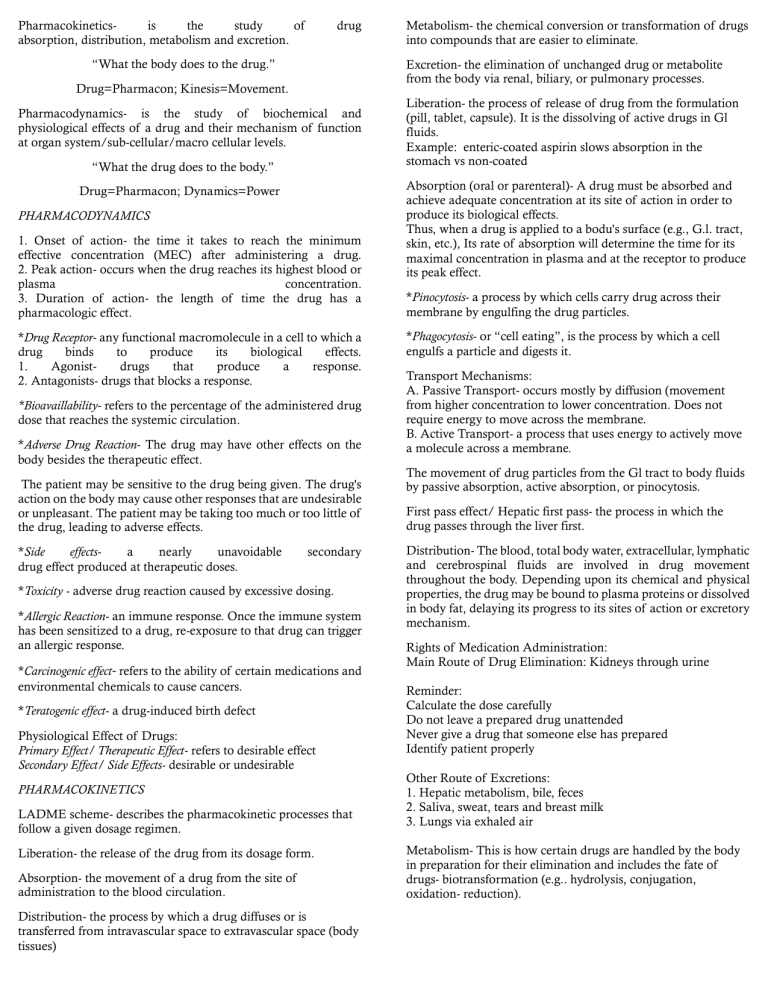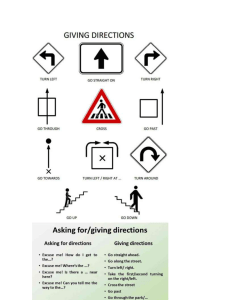
Pharmacokineticsis the study of absorption, distribution, metabolism and excretion. drug “What the body does to the drug.” Excretion- the elimination of unchanged drug or metabolite from the body via renal, biliary, or pulmonary processes. Drug=Pharmacon; Kinesis=Movement. Pharmacodynamics- is the study of biochemical and physiological effects of a drug and their mechanism of function at organ system/sub-cellular/macro cellular levels. “What the drug does to the body.” Drug=Pharmacon; Dynamics=Power PHARMACODYNAMICS 1. Onset of action- the time it takes to reach the minimum effective concentration (MEC) after administering a drug. 2. Peak action- occurs when the drug reaches its highest blood or plasma concentration. 3. Duration of action- the length of time the drug has a pharmacologic effect. *Drug Receptor- any functional macromolecule in a cell to which a drug binds to produce its biological effects. 1. Agonistdrugs that produce a response. 2. Antagonists- drugs that blocks a response. *Bioavaillability- refers to the percentage of the administered drug dose that reaches the systemic circulation. *Adverse Drug Reaction- The drug may have other effects on the body besides the therapeutic effect. The patient may be sensitive to the drug being given. The drug's action on the body may cause other responses that are undesirable or unpleasant. The patient may be taking too much or too little of the drug, leading to adverse effects. *Side effectsa nearly unavoidable drug effect produced at therapeutic doses. Metabolism- the chemical conversion or transformation of drugs into compounds that are easier to eliminate. secondary *Toxicity - adverse drug reaction caused by excessive dosing. *Allergic Reaction- an immune response. Once the immune system has been sensitized to a drug, re-exposure to that drug can trigger an allergic response. *Carcinogenic effect- refers to the ability of certain medications and environmental chemicals to cause cancers. *Teratogenic effect- a drug-induced birth defect Physiological Effect of Drugs: Primary Effect/ Therapeutic Effect- refers to desirable effect Secondary Effect/ Side Effects- desirable or undesirable PHARMACOKINETICS LADME scheme- describes the pharmacokinetic processes that follow a given dosage regimen. Liberation- the release of the drug from its dosage form. Absorption- the movement of a drug from the site of administration to the blood circulation. Distribution- the process by which a drug diffuses or is transferred from intravascular space to extravascular space (body tissues) Liberation- the process of release of drug from the formulation (pill, tablet, capsule). It is the dissolving of active drugs in Gl fluids. Example: enteric-coated aspirin slows absorption in the stomach vs non-coated Absorption (oral or parenteral)- A drug must be absorbed and achieve adequate concentration at its site of action in order to produce its biological effects. Thus, when a drug is applied to a bodu's surface (e.g., G.l. tract, skin, etc.), Its rate of absorption will determine the time for its maximal concentration in plasma and at the receptor to produce its peak effect. *Pinocytosis- a process by which cells carry drug across their membrane by engulfing the drug particles. *Phagocytosis- or “cell eating”, is the process by which a cell engulfs a particle and digests it. Transport Mechanisms: A. Passive Transport- occurs mostly by diffusion (movement from higher concentration to lower concentration. Does not require energy to move across the membrane. B. Active Transport- a process that uses energy to actively move a molecule across a membrane. The movement of drug particles from the Gl tract to body fluids by passive absorption, active absorption, or pinocytosis. First pass effect/ Hepatic first pass- the process in which the drug passes through the liver first. Distribution- The blood, total body water, extracellular, lymphatic and cerebrospinal fluids are involved in drug movement throughout the body. Depending upon its chemical and physical properties, the drug may be bound to plasma proteins or dissolved in body fat, delaying its progress to its sites of action or excretory mechanism. Rights of Medication Administration: Main Route of Drug Elimination: Kidneys through urine Reminder: Calculate the dose carefully Do not leave a prepared drug unattended Never give a drug that someone else has prepared Identify patient properly Other Route of Excretions: 1. Hepatic metabolism, bile, feces 2. Saliva, sweat, tears and breast milk 3. Lungs via exhaled air Metabolism- This is how certain drugs are handled by the body in preparation for their elimination and includes the fate of drugs- biotransformation (e.g.. hydrolysis, conjugation, oxidation- reduction). Routes of Drug Administration: Excretion: The kidney is the most important organ for drug excretion but the liver, lung and skin are also involved in drug elimination. Drugs excreted in feces are mostly derived from unabsorbed, orally ingested drugs or from metabolites excreted in the bile and not reabsorbed by the intestine. Drug Administration Rules for Administration (Drug Route): * Otic Route * Sublingual and Buccal Routes * Rectal Route * Vaginal Route * Oral Route * Ocular Route * Cutaneous Route * Injection Routes Half-life- the time it takes for one-half (50%) of the drug concentration to be eliminated. Reminder: Give only drugs the doctor orders Wash your hands Prepare in a well-lit area Focus on task; avoid distractions Liver- primary site of metabolism

